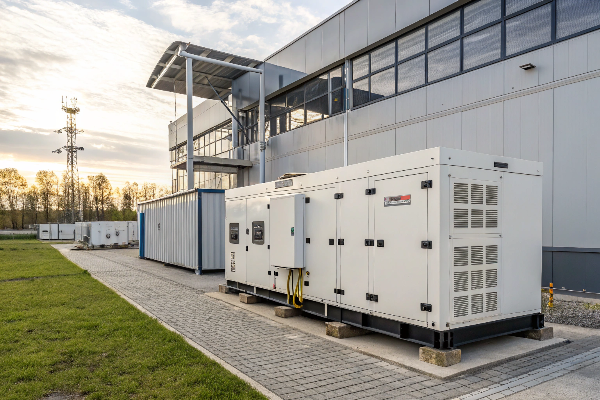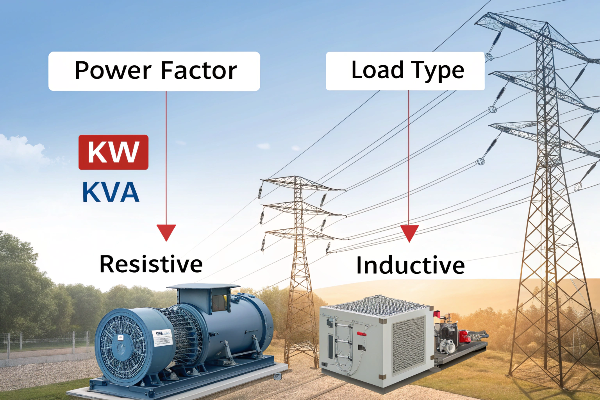
Calculating the number of KVA generators required for your facility involves understanding your total power needs, including both running and surge power1. Getting the size right ensures efficiency, reduces operational costs, and prevents overloading.
By calculating the total power demand, including starting (surge) and running power, you can determine the required generator size in kVA.
This guide will walk you through the key steps to accurately calculate your generator needs.
What are the key steps to calculate the total power requirement for a generator in kVA?
To determine how many KVA generators you need, follow these steps to estimate the total power required for your equipment and systems.
You need to account for the total running load, starting power, and adjust for power factor2.

Step-by-Step Calculation:
- List all equipment and devices in your facility that will be powered by the generator.
- Identify the running power (in kW) for each piece of equipment. This information is typically found on the equipment's nameplate or user manual.
- Determine the starting power for equipment with motors or compressors (e.g., air conditioners, pumps). Starting power can be 2–3 times the running power.
- Sum the running power of all equipment to get the total running load (in kW).
- Add the starting power for motor-driven equipment to calculate the peak load or surge power.
- Adjust for power factor (PF): The power factor is usually 0.8 for most equipment, which affects the conversion of kW to kVA.
- Convert kW to kVA by dividing the total running load by the power factor:
[
\text{KVA} = \frac{\text{Total kW}}{\text{Power Factor}}
] - Add a margin (typically 20–30%) to allow for future expansion or load spikes.
Example Calculation:
- 10 computers with 0.2 kW each = 2 kW
- 2 printers with 0.5 kW each = 1 kW
- 3 air conditioners with 2.5 kW each = 7.5 kW
- 1 refrigerator with 0.3 kW = 0.3 kW
- Wi-Fi Router = 0.01 kW
Total running load = 2 + 1 + 7.5 + 0.3 + 0.01 = 10.81 kW
For surge load (e.g., air conditioners):
- Air conditioners starting power (x3) = 7.5 kW × 3 = 22.5 kW
Total peak load = 10.81 kW + 22.5 kW = 33.31 kW
Now, account for the power factor (assumed at 0.8):
[
\text{KVA} = \frac{33.31 \, \text{kW}}{0.8} \approx 41.64 \, \text{KVA}
]
To allow for future expansion, you would add a 25% margin:
[
41.64 \, \text{KVA} \times 1.25 = 52.05 \, \text{KVA}
]
In this case, you would need a 55 KVA generator to handle the running and surge loads comfortably.
How do you account for starting (surge) power and running power when sizing a generator?
Generators must be sized to handle both the running power (constant load) and starting (surge) power, which can be significantly higher for equipment with motors.
Starting power, also known as surge power, can be 2–3 times the running power for motor-driven equipment.

Understanding surge power:
- Running power refers to the power an appliance or equipment needs during normal operation.
- Starting power (surge power) is the extra power required to start equipment with motors or compressors, such as air conditioners, refrigerators, and pumps.
Key considerations:
- Motor-driven equipment like air conditioners or elevators requires a surge that can last for a few seconds to a minute.
- The surge is typically 2–3 times the running power for these devices.
- Surge power must be factored into the generator size to avoid overloading or failure during startup.
Example calculation for surge power:
- Air conditioner running power = 2.5 kW
- Air conditioner starting power = 2.5 kW × 3 = 7.5 kW
- Total surge power for 3 AC units = 7.5 kW × 3 = 22.5 kW
This surge power is added to the total running load to calculate the peak load, which helps you determine the size of the generator.
Why surge power is critical:
If the generator is undersized and cannot handle surge power, it will trip or fail to start equipment, leading to downtime and possible damage to sensitive devices.
What factors, such as power factor and load type, influence the kVA rating of a generator?
Several factors, such as the power factor and load type (resistive or inductive), affect how efficiently a generator converts kW to kVA.
Understanding the power factor and load type ensures the generator can handle both steady and fluctuating loads.

Key factors that influence kVA rating:
-
Power Factor (PF):
- The power factor indicates how efficiently a generator’s power is used. It’s typically 0.8 for most office equipment.
- If the power factor is lower (e.g., for inductive loads like motors), you’ll need a generator with a higher kVA rating to meet the same kW requirements.
-
Load Type (Resistive vs. Inductive):
- Resistive loads (like lighting and heating) use power efficiently, and the power factor is close to 1.
- Inductive loads (like motors and air conditioners) draw more current to generate magnetic fields, resulting in a lower power factor and requiring more kVA.
-
Load Characteristics:
- Continuous Load: A load that runs consistently without fluctuation (e.g., lighting).
- Intermittent Load: A load that operates intermittently (e.g., printers or pumps).
- Variable Load: A load that fluctuates depending on usage (e.g., air conditioners).
-
Generator Efficiency:
- The efficiency of the generator itself can affect how much output it produces at a given input, but this is typically a minor factor compared to other considerations.
How power factor impacts generator sizing:
| Power Factor | kVA Required | kW Power |
|---|---|---|
| 1.0 | Lower kVA required | More efficient use of power |
| 0.8 | Higher kVA required | Standard for most equipment |
| 0.6 | Even higher kVA required | Less efficient, often for motors |
Example:
If you have a 50 kW running load with a 0.8 power factor, the required kVA would be:
[
\frac{50 \, \text{kW}}{0.8} = 62.5 \, \text{kVA}
]
If the load had a 0.6 power factor, you would need:
[
\frac{50 \, \text{kW}}{0.6} = 83.33 \, \text{kVA}
]
Why power factor matters:
The lower the power factor, the more kVA is needed to produce the same kW. This is crucial when selecting generators for motor-heavy environments or when operating with equipment that requires high starting power.
Conclusion
To calculate how many KVA generators you need, assess the total running and surge load, adjust for power factor, and factor in future growth. Understanding these calculations ensures that your generator can handle both steady and fluctuating loads efficiently and safely.

